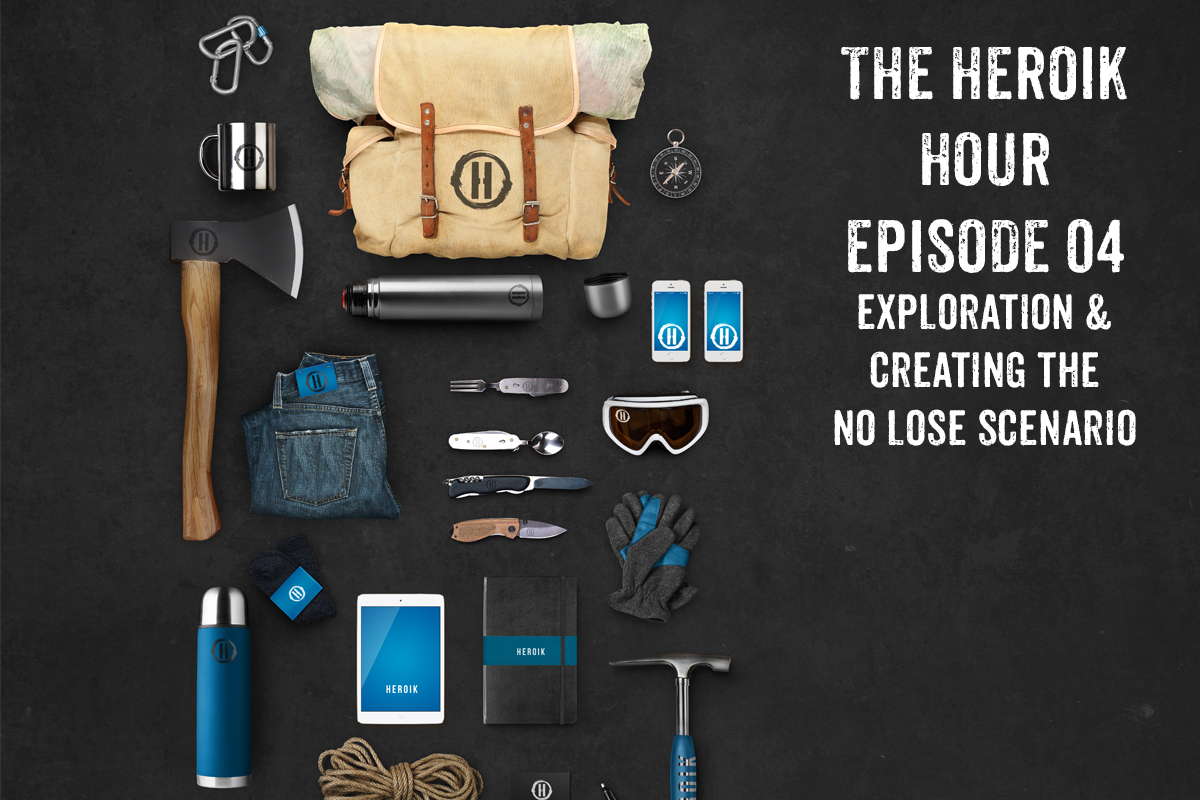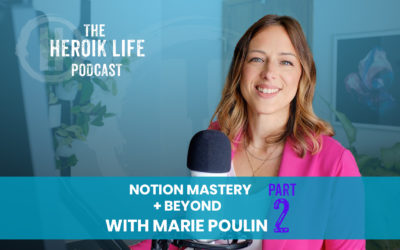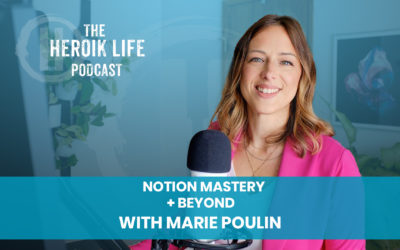Disclaimer: Below are the show notes and script that covers the podcast more or less. These notes will be more concise and tight as I find my narrative style and framework for the show. So bear with me.
Welcome to THE Heroik Hour Podcast and thank you so much for tuning in to episode Four. I’m your host Nicholas McGill, Chief Experience Officer for Heroik Media, and I’m going to share a little bit of technology, leadership and culture -Some Heroik TLC to help get you mission ready for life.
If you like what you hear in this and other episodes, Please subscribe to this podcast, share it with a friend, check out our website, like us on Facebook at getheroik.com and join us on the insider Group.
In the last few episodes, we’ve been working through the theme, that heroes aren’t born they’re MADE, and made is an acronym for 4 core Heroik values of mastery, abundance, discernment, and exploration. The last episode was a doozy, a long one about discernment. This one will be short and sweet.
Exploration happens when we think of all the what if’s and begin to take action, pursue the upside of the what if’s. Usually our reptilian brains stop us from taking risks and tells us it’s better to go with what we know.
But the reality is in any given day, you deal with a lot of uncertainty, a lot of unknowns and what if’s you regularly ignore to feel safe and comfortable, but it’s a false sense of security in a life that may not be giving you all you want at the moment.
You could…
- get in a car wreck, or hit by a bus on your way to work at any time. Statistically, these are common.
- get fired from your job, downsized, rightsized, outsourced, outsized, or take a 20% pay cut and have Fridays off as many people do these days.
- Live a boring, soul crushing, unfulfilled life, that has you restless, seeking therapy, medication, running like a hamster in a hamster maze when you’re not in the traditional rat race of the status quo.
- Get eaten by a shark if you swim in the ocean. …and if that fear is keeping you from swimming in the ocean, yet you still drive to work everyday, you’ve done the math all wrong.
We don’t like to think about it, we prefer to avoid risks altogether in favor of a guarantee. We like to believe in fairy tale guarantees like:
“Just keep your head down, work hard and it will pay off in the end”
the big crash of 2008, and all the economic activity, innovation, good, bad and ugly since, should convince you of one thing, there is no guarantee, and for many, there’s not really a fair chance, that you’ll hit it big and reach the great life on a prescribed path and follow the rules of yesterday. To all you corporate pro’s pushed out of the game by the big crash, you know this better than most.
And you think you’re playing it safe, by taking the prescribed path?
There is no way to account or cover for all of life’s what if’s, and when you think about it we’re way more vulnerable than we care to think about. There’s plenty of risk Business as usual that we don’t like to think about but we should, because it can help give us perspective when we compare it to what we think of as risky, adventurous or exploratory.
- And on the upside in the land of what ifs,
- What if you found a way to increase the amount of joy and fulfillment in your life?
- What if you discovered that you really loved doing something else?
- What if you increased your quality of life by 10% ?
These are all part of the ROI of exploration. And this is why I do it, I take measured risks, pack a chute and get excited and enjoy the ride. It doesn’t always workout in my favor, but I’ve found ways to mitigate risks, and have a soft landing and recovery plan.
Now-If you had a parachute, a way to land softly no matter what you did, what would you try?
What would you explore?
On this episode, I’m going to guide you through the things I do to preserve that Heroik and adventurous spirit, and mitigate the risks and ensure I still can come home and pay the bills. Whether you’re an entrepreneur planning to start a business, or thinking of a great adventure you want to go on, these tips will help provide you with the mindset, and the means to make it work financially, and mentally, so you can enjoy the journey.
Contingency, Risk Mitigation and Recovery Plan.
The major what if – is what if whatever you’re doing you completely fail at or suck at? This is usually the worst case scenario, and I’m going to increase your chances of long term success and resiliency, by sharing some tools and techniques I use.
I may take risks I try to measure them as best I can. I have a family to care for, and I have to be smart.
I develop a gameplan of a no-lose scenario. You may have heard of the no-win scenario, or if you’re a star trek fan you can remember the Kobayashi Maru, or the famous training exercise for which there was no known path to victory – until of course Jim Kirk hacked the scenario to make it possible.
I prefer engineering a no-lose scenario, even if as just as a personal parachute for myself. This can be a simple exercise of contingency planning where you know exactly what you’ll do to make end’s meat, and upcycle any result, even if it all goes horribly wrong.
Heroik Secrets to Creating a No-Lose Scenario
- Document the entire journey. Take pictures, record videos, write journals, blog about it. Capture the journey – this is critical. Write the story as you go. You might not have the runway, funds, or time and clear mind to write the story later on. You need to develop the habit of telling the story as you go, if for no other reason than an insurance policy. This must become part of your day job, if you’re unwilling to do this, I question your resolve.
- Newsflash – stories are important.
- Stories sell. You’re ability to tell the story is what gets the venture funded. You don’t have to wait for a successful conclusion to start telling the story. Attracting attention to your cause, your ambition, aspirations and goals, also acts as a success multiplier and a safety net. You’ve built an audience on a worthy endeavor that you can cash in on no matter what.
- It attracts support and helps you build a team and advisors who can help you on the journey
- It attracts attention and build an audience
- It can attract other resources and even funding for your venture, still to this day in 2016. Afterall, that’s all kickstarter is a glorified, pre-sales, storytelling platform, that usually describes a best case scenario.
- Story Telling is important – so studying better methods and means of story-telling and media are important.
- Communication
- Speaking, Audio and podcasts
- Visual Communication
- The ability to draw, paint, sketch, act and present,
- Create Slide Decks, Photos, Videos, Animations, Explainer videos, Data visualizations, Infographics
- Writing
- Copy writing
- Culture building
- Inspiring and motivating others
- Inspiring and motivating yourself.
- If you’ve got the technical media skills, and learn how to tell a story, this can save your bacon regardless of if you succeed or fail. You can build an audience now based of what you’re doing.
- If no one’s interested in what you’re doing that’s something to consider and reflect on as well. Maybe you haven’t shared the implications, maybe they don’t have trust or faith that you’ll see it through. Think about it and decide the appropriate way to address it. Don’t ignore it though.
The goal is to be in a good position to sell the story no matter how it turns out – Plan to document the story well, so the documentary, the lessons learned, the behind the scenes story, the making of, will help fund current and future expeditions. STORY IS ALWAYS PART OF THE PATH AND PRODUCTION OF EXPLORATION. IN FACT IT’S AN ESSENTIAL PRODUCT MODEL. Think about how will you sell the story and who you’ll sell it to.
So the media model, of story-telling, audience building, is a parachute in and of itself, so pack your chute now, and this will save your life and lead to even better opportunities.
- Any lessons learned, are lessons that can be taught to others. Look for lessons along the way, document them well, and you can create courses, talks, products to help others learn. And for future business models, you can address any issues with improvements. Think about some courses and lessons you can give from your experience.
- There are many different turn-key courseware solutions out there like Udemy and Sensei to help you.
- Don’t go it alone. Assemble a hearty team.
You can increase your likelihood of success if you have a team, or at least have a personal advisory board and guides to help you along the way.
Along with developing the story, creating a platform, a dedicated, focused space to rally a team can serve you well. For some this involves creating or attending a watering hole favored among fellow explorers.
The Heroik insider group is an example of this. It’s an exclusive, non-solicitous collaborative space for people to share ideas, connect, vet, and think up solutions. You can find it on our website
When I start a project, or work with a company, I think back to the days when I was a kid building a fort, and I look at the people who may be involved and I ask if they want to help build the fort? And the glory and clubhouse membership only went to those who helped build it and brought value.
These days in the grown up world, there are a lot of people who will be enthusiastic and excited about your endeavor, but when you ask them to join you, to help build it, many disappear. Most want to walk through the brick walls, after you do all the hard work of busting through them. There’s a lot of coat tail riders out there, who want to share in the spoils but not in the hard work. This is a majority of people. This is like 98% of the people you talk to about your project. But don’t write them off yet. You know what we call them? CUSTOMERS! That’s right, send them updated newsletters on how the development process is going, warm them up as things come into place, and then when it comes time to ship or launch, ask them THEN, if they’d like to become a part of it, and if they do, they’ll have to pay for their seat.
Equity, treasure, the meat of the spoils of exploration go first and foremost to those doing the work.
Checklist for gathering a team
-The Shackleton test- describe the journey in all it’s truth, gore and risk.
“Men wanted for hazardous journey, small wages, bitter cold, long months of complete darkness, constant danger, safe return doubtful, honor and recognition in case of success.”
Those who are confident in their abilities will stick around. Those who were looking for the easy button to wealth and fame can get on your mailing list. If you created an ad that described endless riches, free beer, bacon and donuts, you’d get plenty of people to show up but very few who actually end up joining you on the journey. Be mindful of this as you tell the story to attract the team.
Let’s recap
- Tell the story early, before you start, as you start and as you go,
- You can sell this later on, you can use it to get support and build an audience.
- It helps you answer a fundamental brand question – what are you exploring – it makes for far more interesting conversations
- Learn the skills master a few media and storytelling skills
- Allows you to build the story into experiential products – that you’ll use to fundraise, or as a recovery business model, or gateway to the next gig.
- Think about the little lessons and things you’ll conquer along the way – you can turn this into a courseware pivot , consulting pivot or augment your current business model with the support it.
- Don’t Go it alone. Get advisors and guides
- Build a robust team of gritty doers- don’t sugar coat the journey – be honest to attract the team with real grit.
Exploration is not about one journey, it’s about many. It’s about many stories unfolding at once. There’s the journey you think you’re on, and where you think and hope it will take you, and then all the forks and sub-plots, that can become priorities and pivots at any given moment. If you’re ready, if you can apply hour habits of mastery, abundance, discernment and exploration, you too can be mission ready for life, and become Heroik in your own right.
Boldly exploring the ever expanding space of technology, leadership and culture together, through designing better lens for the human experience, we’ll breathe life into new insights, new products, new industries, identify new opportunities, that help to advance us, and foster meaningful connections with others.
Thank you for going on this journey with me- and I’ll catch you in the next episode of the Heroik Hour.





0 Comments